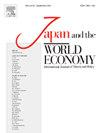Towards sustainable floral business in Japan: Evidence from dynamic demand system between domestic and imported cut flowers
IF 1.2
4区 经济学
Q3 ECONOMICS
引用次数: 0
Abstract
Japan has been addressed the largest market for cut flower imports and consumption in Asia. Since 2000, the floral industry in Japan has faced a decline in production due to an aging workforce and rising costs, while domestic demand for cut flowers has remained stable. The supply-demand gap has been boosted by increasing imports. The import and household consumption survey data from January 2002 to December 2021 and dynamic EC-AIDS model are employed to estimate the expenditure, own-price compensated, and cross-price elasticities between domestic and imported cut flowers in Japan. Our findings show that domestic floral business promotion policy enacted since 2014 had no significant impacts on structural change of demand between imported and domestic cut flowers. The empirical results indicate that domestic cut flowers in Japan are substitutes for those from major import source countries, though the degree of substitutions are limited. Notably, not only the complementary relationship of orchids but also an expenditure elasticity with 2.62 of Chrysanthemum between Japan and Taiwan, suggesting a greater sustainable potential in the Japanese Market.
日本花卉产业的可持续发展:来自国内和进口鲜切花动态需求系统的证据
日本已成为亚洲最大的鲜切花进口和消费市场。自2000年以来,由于劳动力老龄化和成本上升,日本花卉产业面临产量下降,而国内对切花的需求保持稳定。不断增加的进口加剧了供需缺口。采用2002年1月至2021年12月的进口和居民消费调查数据和动态EC-AIDS模型对日本国内和进口切花的消费支出、自有价格补偿和交叉价格弹性进行了估算。研究发现,2014年以来出台的国内花卉产业促进政策对进口和国内切花需求的结构性变化没有显著影响。实证结果表明,日本国内鲜切花对主要进口来源国鲜切花具有替代作用,但替代程度有限。值得注意的是,日本和台湾之间不仅有兰花的互补关系,而且菊花的消费弹性为2.62,表明日本市场具有更大的可持续潜力。
本文章由计算机程序翻译,如有差异,请以英文原文为准。
求助全文
约1分钟内获得全文
求助全文
来源期刊

Japan and the World Economy
ECONOMICS-
CiteScore
2.60
自引率
0.00%
发文量
26
审稿时长
46 days
期刊介绍:
The increase in Japan share of international trade and financial transactions has had a major impact on the world economy in general and on the U.S. economy in particular. The new economic interdependence between Japan and its trading partners created a variety of problems and so raised many issues that require further study. Japan and the World Economy will publish original research in economics, finance, managerial sciences, and marketing that express these concerns.
 求助内容:
求助内容: 应助结果提醒方式:
应助结果提醒方式:


